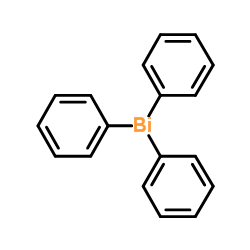三苯基铋

三苯基铋结构式

|
常用名 | 三苯基铋 | 英文名 | Triphenylbismuth |
|---|---|---|---|---|
| CAS号 | 603-33-8 | 分子量 | 440.292 | |
| 密度 | 1,585 g/cm3 | 沸点 | 310°C | |
| 分子式 | C18H15Bi | 熔点 | 78-80 °C | |
| MSDS | 中文版 美版 | 闪点 | 242°C/14mm | |
| 符号 |

GHS07 |
信号词 | Warning |
|
Correlation of changes in the mandible and retina/choroid vasculature of a rat model of BRONJ.
J. Craniomaxillofac. Surg. 43 , 1144-50, (2015) Bisphosphonate-related osteonecrosis of the jaw (BRONJ) causes bones of the mandible and maxilla to become necrotic and protrude into the oral cavity. Compromised blood supply to bone is also a feature of BRONJ. The design of this study was first to use our e... |
|
|
Cytotoxic effects of triphenylbismuth on rat thymocytes: comparisons with bismuth chloride and triphenyltin chloride.
Environ. Toxicol. 17(5) , 472-7, (2002) The biomedical and industrial uses of organobismuth compounds have become widespread, although there is limited information concerning their cytotoxicity. Therefore, the actions of triphenylbismuth on rat thymocytes were examined using a flow cytometer with e... |
|
|
Osteolytic potential of triphenyl bismuth as an alternative contrast medium in acrylic bone cement.
J. Biomed. Mater. Res. B. Appl. Biomater. 75Bth ed.,, 64, (2005) Radiopaque cement containing barium sulfate causes significantly more bone resorption in vivo and in vitro than radiolucent cement. The aim of this study was to investigate the osteolytic potential of an alternative radiopaque agent, triphenyl bismuth (TPB). ... |
|
|
Relativistic effects in triphenylbismuth and their influence on molecular structure and spectroscopic properties.
Phys. Chem. Chem. Phys. 14(44) , 15520-4, (2012) Relativistic effects in triphenylbismuth have been investigated using a combined experimental and theoretical approach. The influence of these effects on the molecular structure (determined by gas electron diffraction) has been evaluated by means of quantum c... |
|
|
Development of a radiopaque, autopolymerizing dental acrylic resin.
J. Prosthodont. 3(4) , 213-8, (1994) Current prosthetic acrylic resins are radiolucent and cannot be imaged using standard radiographic techniques. If accidentally impacted or ingested, delays in localizing or removing the foreign body may be life-threatening. The purpose of this study was to ev... |
|
|
The effect of triphenylbismuth on the radiopacity and performance properties of compression- and injection-molded denture resins.
J. Prosthodont. 9(1) , 23-9, (2000) Methods of incorporating radiopaque triphenylbismuth into an experimental compression-molded and injection-molded heat-polymerized resins were determined. The transverse flexural properties, radiopacity, and color stability of the resins containing triphenylb... |
|
|
Structural motifs in phenylbismuth heterocyclic carboxylates--secondary interactions leading to oligomers.
Dalton Trans. 41(3) , 1004-12, (2012) The reaction of triphenylbismuth [BiPh(3)] with several heterocyclic carboxylic acids was explored. Seven crystalline compounds, [PhBi(2-O(2)C-3-(OH)C(5)H(3)N)(2)(2-O(2)C-3-(OH)C(5)H(3)NH)] (5), [(Bi(2-O(2)C-3-(OH)C(5)H(3)N)(4))(C(5)H(5)NH)(C(5)H(5)N)] (7), [... |
|
|
Cytotoxicity evaluation of a new radiopaque resin additive--triphenyl bismuth.
Dent. Mater. 8(1) , 54-9, (1992) Triphenyl bismuth (Ph3Bi) is a promising new additive for making biomedical resins visible on x-ray images. We evaluated the cytotoxicity of Ph3Bi, both alone and as a component of a denture resin, as an initial step in determining its biocompatibility. These... |
|
|
Radiopacity in bone cements using an organo-bismuth compound.
Biomaterials 23(16) , 3387-93, (2002) In a joint replacement surgery it is vital for bone cement to be radiologically detectable. Consequently, heavy metal salts of barium and zirconia are incorporated as a contrast medium for this purpose. The addition of such particulate additives, however, can... |
|
|
Thermomechanical investigation of poly(methylmethacrylate) containing an organobismuth radiopacifying additive.
J. Biomed. Mater. Res. 31(3) , 339-43, (1996) Previously we demonstrated the feasibility of using up to 24% triphenylbismuth (TPB) as a radiopaque, monomer-miscible additive for dental acrylic resins. In this study we examined the influence of TPB on thermomechanical properties of a representative polyme... |